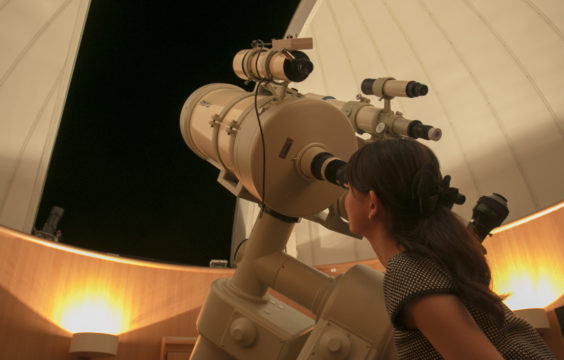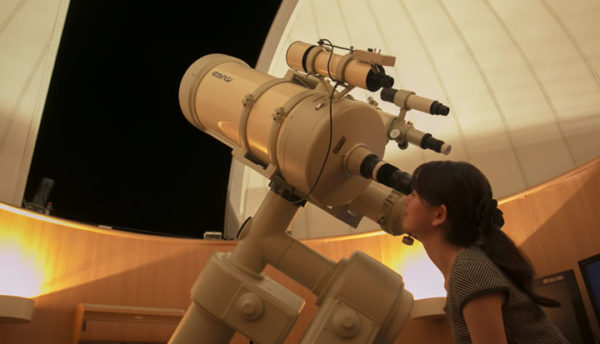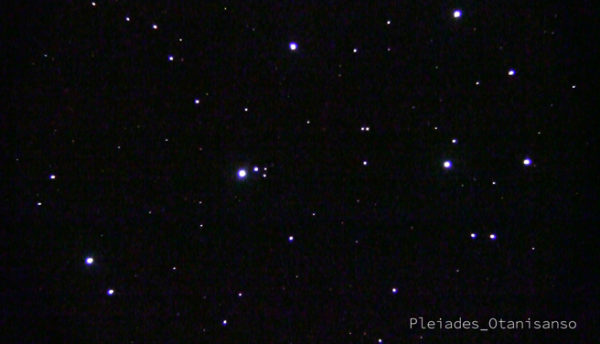- Astronomical Observatory
- 2019/05/21
【April in the Observatory】Observe the star Arcturus, representative of the night sky in spring. Come see the great triangle of spring!
In May, we’ll be showing you the powerful full moon, as well as the spring stars Arcturus, Spica, Denebola, and Cor Caroli, which together make up the “Spring Diamond.”

In May, we’ll be observing the New Moon, Waxing Moon, and Full Moon, perfect for the theme of new beginnings
Greetings from the Otani Sanso Astronomical Observatory Dome.Today we’ll be discussing Nagato’s night skies in May, 2019. During May, visitors will be able to view the beauty of the full moon, as it will become full during operating hours at the astronomical observatory. To be specific, from May 8 (Wed) – 19 (Sun), we will observe the New Moon as it transforms into a Waxing Moon (during which phrase the right side of the moon will be visible), and finally into a Full Moon. In ancient Japan, when the lunar calendar was in regular use, the phases of the moon governed the cycles of people’s daily lives. This cycle began with the New Moon and reached completion with the Full Moon. The Full Moon marked a turning point, signifying that all things had reached a point of completion. As the words, “Make a wish on the New Moon and it will come true,” suggests, the light given off by the moon shines with a beauty that surpasses all the other wishing stars. Our earth’s only “Moon” shares a very close relationship with our global environment. Enjoy this opportunity to take a look at our Moon a little bit closer. (Photo: Taken at the Otani Sanso Astronomical Observatory Dome. It shows the “Surface of the Moon” as seen from earth.
As in April, we’ll be able to see the Great Spring Curve and the “Spring Diamond”
First, let’s look for the Great Spring Curve with Mizar (in the Big Dipper)
Of course, as in April’s night skies, we’ll be able to observe the “Great Spring Triangle,” the “Great Spring Curve,” and the “Spring Diamond.” Let’s begin by locating the Big Dipper, which shimmers high in the northern sky. If we follow the curve of its ladle shape and continue on that line towards the southern sky, we’ll find the orange-colored first magnitude star Arcturus (in the constellation Boötes). If we extend our curve even further, the first magnitude star Spica (in the constellation Virgo) will appear, shimmering white. Extending to the four stars past Spica that form the shape of a stand in the constellation Corvus, this great curve is known as the “Great Spring Curve.”Next, let’s find the Great Spring Triangle and the Spring Diamond
Once we’ve located Mizar, and then Arcturus and Spica, let’s find the star Denebola, which is part of the constellation of Leo. It lies just across from Arcturus. If you draw a line connecting Arcturus, Spica, and Denebola, you’ve completed the “Great Spring Triangle.” Just across from Spica, near the “tail” portion of the constellation Ursa Major, you’ll find the star Col Caroli in the constellation of Canes Venatici. If you connect Col Caroli to Denebola, you’ll find the “Spring Diamond.” In the large telescope at Otani Sanso’s astronomical observatory dome, you’ll be able to observe Arcturus, Mizar, and Col Caroli. You may even be able to observe stars like Alcor and Col Caroli, double stars in white and purple, which are difficult to discern with the naked eye.See information from the Astronomical Observatory Dome from April
Greek myths associated with the stars of May: Corvus, the Crow Constellation
The “Crow Constellation” Corvus that shimmers in the southern spring skies
The constellation Corvus can be seen in the southern sky, and forms the last portion of the Great Spring Curve. In Japan, it can be observed for a period of five months, from March to July, during which the best time to view it is in late May. The constellation’s four stars form a shape like a pedestal, making them relatively easy to spot (in Japan, the constellation is also called the “Sail Star”). The key to finding it are the two stars in the upper part of the constellation. Above these lies Spica.Why are crows black? (According to Greek mythology)
Have you ever heard that crows are actually white birds? Long ago, crows were the servants of the sun god Apollo, and they were birds with beautiful white plumage that could speak human languages. One day, however, Apollo asked them to draw water, and they visited a spring. As the crows were drawing water, they notifced a fig tree, but its fruit was not yet ripe. The crows waited until the figs ripened, and ate them before returning with the water, making them very late. As an excuse, the crows brought back with them a snake from the spring, and told Apollo that it prevented them from drawing water. As punishment for lying to Apollo, the birds’ plumage was turned from white to black, and they forgot human speech.Stellar Objections Expected to be Visible in May
- May 1 (Wed) – 7 (Tue) Arcturus, Mizar, Col Caroli
- May 8 (Wed) – 19 (Sun) the Moon, Mizar, Col Caroli *New Moon (May 5), Waxing Moon (May 12), Full Moon (May 19)
- May 20 (Mon) – 31 (Fri) Arcturus, Mizar, Col Caroli
Please check the National Astronomical Observatory of Japan website for sunset times in Yamaguchi Prefecture.(See:National Astronomical Observatory of Japan Website)。
Making a Reservation at the Astronomical Observatory

Details
- Observatory Hours… 7:30 p.m. – 10:10 p.m.
- Closed on… Every Tuesday
- Location… Otani Sanso Roof (Just beside the gallery on the 8th floor)
- Price… Free for overnight guests (Viewings available to those who reserve first)
- Using the Observatory… Viewings are available to those who reserve first (12 seats per viewing)
Observation Times
- 7:30 p.m., 7:50 p.m.
- 8:10 p.m., 8:30 p.m., 8:50 p.m.
- 9:10 p.m., 9:30 p.m., 9:50 p.m.
How to Make a Reservation
Please inform us of your desired reservation time from the times listed above (Please tell us via telephone, or write it in the “requests” field) *You may not be able to participate in a viewing if a time slot is fully booked, or due to weather conditions. *Should you be unable to participate in a viewing due to weather conditions, you will be able to see a video from a past viewing.See information from the astronomical observatory dome
■Frequently Asked Questions "Why is there an astronomical observatory on the roof of Otani Sanso?" The president of Otani Sanso, a great fan of the poems of Nagato/Senzaki-born Kaneko Misuzu, built the observatory out of a desire to "share the beautiful stars of Nagato with our guests, too." In fact, it was through a chance meeting via the Kaneko Misuzu Exchange Association that the president met with Dr. Haoru Saji, who greatly affected the president with the beauty of the stars he could see from the observatory at Tamagawa University even during the daytime. "There's much more than your eyes can see," Dr. Saji told him. "Let's take a look at the daytime stars." When you look up at the starry skies of Nagato, here, surrounded by nature, we hope you'll make memories to take home with you that you can look back on fondly.
Night Sky Trivia
The Speed of Light
- Light moves at a speed of approximately 300,000 km per second (7.5 revolutions around the Earth), and can cover 9.46 trillion km in a year.
- It takes light from the sun 8 minutes and 19 seconds to reach the earth.
- It takes 8 minutes and 19 seconds for light from the sun to reach the Earth.
Distances in Space
- Because space is so vast, we use “light years” and “astronomical units (AU)” to describe the distances between stars.
- 1 light year = the amount of distance light can travel in one year (9.5 trillion km)
- 1 astronomical unit = the distance between the sun and the Earth (approx. 150 million km)
Earth Time
- There are 24 hours in one day, but it takes 23 hours and 56 minutes for a rotation of the earth, leaving a margin of 4 minutes.
- The reason we have “leap years” is because the Earth’s orbital period around the sun is just shy of 365 Earth days.
- 1 rotation of the Earth (23 hours 56 minutes) = 400 m/sec
- 1 revolution of the Earth (365 days) = 30 km/sec
If you’d like to see more information about the night skies, the National Astronomical Observatory of Japan is extremely interesting. Please take a look.


